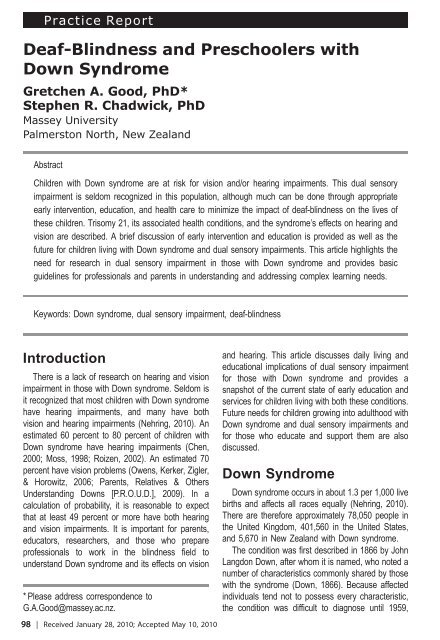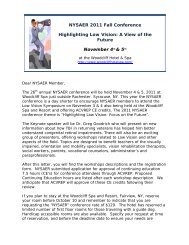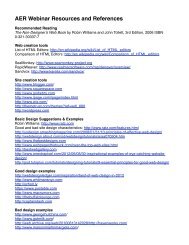Association for Education and Rehabilitation of the ... - AER Online
Association for Education and Rehabilitation of the ... - AER Online
Association for Education and Rehabilitation of the ... - AER Online
You also want an ePaper? Increase the reach of your titles
YUMPU automatically turns print PDFs into web optimized ePapers that Google loves.
Practice Report<br />
Deaf-Blindness <strong>and</strong> Preschoolers with<br />
Down Syndrome<br />
Gretchen A. Good, PhD*<br />
Stephen R. Chadwick, PhD<br />
Massey University<br />
Palmerston North, New Zeal<strong>and</strong><br />
Abstract<br />
Children with Down syndrome are at risk <strong>for</strong> vision <strong>and</strong>/or hearing impairments. This dual sensory<br />
impairment is seldom recognized in this population, although much can be done through appropriate<br />
early intervention, education, <strong>and</strong> health care to minimize <strong>the</strong> impact <strong>of</strong> deaf-blindness on <strong>the</strong> lives <strong>of</strong><br />
<strong>the</strong>se children. Trisomy 21, its associated health conditions, <strong>and</strong> <strong>the</strong> syndrome’s effects on hearing <strong>and</strong><br />
vision are described. A brief discussion <strong>of</strong> early intervention <strong>and</strong> education is provided as well as <strong>the</strong><br />
future <strong>for</strong> children living with Down syndrome <strong>and</strong> dual sensory impairments. This article highlights <strong>the</strong><br />
need <strong>for</strong> research in dual sensory impairment in those with Down syndrome <strong>and</strong> provides basic<br />
guidelines <strong>for</strong> pr<strong>of</strong>essionals <strong>and</strong> parents in underst<strong>and</strong>ing <strong>and</strong> addressing complex learning needs.<br />
Keywords: Down syndrome, dual sensory impairment, deaf-blindness<br />
Introduction<br />
There is a lack <strong>of</strong> research on hearing <strong>and</strong> vision<br />
impairment in those with Down syndrome. Seldom is<br />
it recognized that most children with Down syndrome<br />
have hearing impairments, <strong>and</strong> many have both<br />
vision <strong>and</strong> hearing impairments (Nehring, 2010). An<br />
estimated 60 percent to 80 percent <strong>of</strong> children with<br />
Down syndrome have hearing impairments (Chen,<br />
2000; Moss, 1998; Roizen, 2002). An estimated 70<br />
percent have vision problems (Owens, Kerker, Zigler,<br />
& Horowitz, 2006; Parents, Relatives & O<strong>the</strong>rs<br />
Underst<strong>and</strong>ing Downs [P.R.O.U.D.], 2009). In a<br />
calculation <strong>of</strong> probability, it is reasonable to expect<br />
that at least 49 percent or more have both hearing<br />
<strong>and</strong> vision impairments. It is important <strong>for</strong> parents,<br />
educators, researchers, <strong>and</strong> those who prepare<br />
pr<strong>of</strong>essionals to work in <strong>the</strong> blindness field to<br />
underst<strong>and</strong> Down syndrome <strong>and</strong> its effects on vision<br />
* Please address correspondence to<br />
G.A.Good@massey.ac.nz.<br />
98 | Received January 28, 2010; Accepted May 10, 2010<br />
<strong>and</strong> hearing. This article discusses daily living <strong>and</strong><br />
educational implications <strong>of</strong> dual sensory impairment<br />
<strong>for</strong> those with Down syndrome <strong>and</strong> provides a<br />
snapshot <strong>of</strong> <strong>the</strong> current state <strong>of</strong> early education <strong>and</strong><br />
services <strong>for</strong> children living with both <strong>the</strong>se conditions.<br />
Future needs <strong>for</strong> children growing into adulthood with<br />
Down syndrome <strong>and</strong> dual sensory impairments <strong>and</strong><br />
<strong>for</strong> those who educate <strong>and</strong> support <strong>the</strong>m are also<br />
discussed.<br />
Down Syndrome<br />
Down syndrome occurs in about 1.3 per 1,000 live<br />
births <strong>and</strong> affects all races equally (Nehring, 2010).<br />
There are <strong>the</strong>re<strong>for</strong>e approximately 78,050 people in<br />
<strong>the</strong> United Kingdom, 401,560 in <strong>the</strong> United States,<br />
<strong>and</strong> 5,670 in New Zeal<strong>and</strong> with Down syndrome.<br />
The condition was first described in 1866 by John<br />
Langdon Down, after whom it is named, who noted a<br />
number <strong>of</strong> characteristics commonly shared by those<br />
with <strong>the</strong> syndrome (Down, 1866). Because affected<br />
individuals tend not to possess every characteristic,<br />
<strong>the</strong> condition was difficult to diagnose until 1959,







